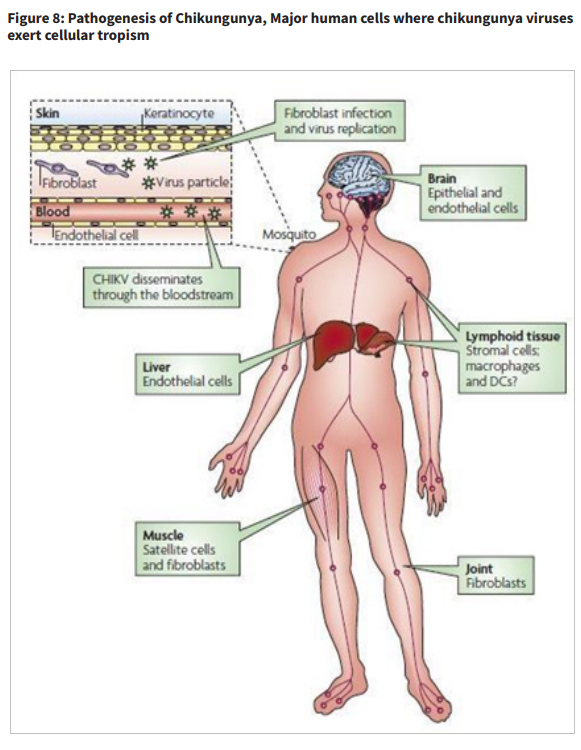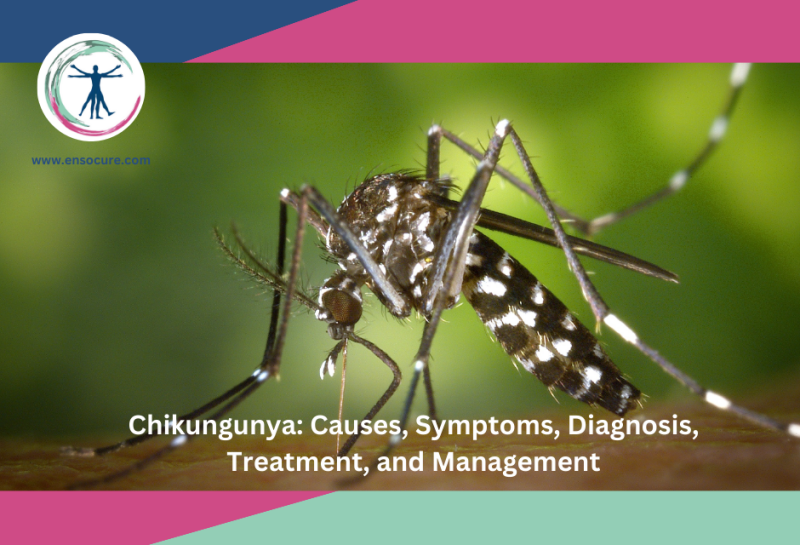Chikungunya, a viral illness transmitted primarily by mosquitoes, has emerged as a significant public health concern in recent years, particularly in tropical and subtropical regions. While the disease remains a matter of concern, what’s fortunate to know is how the number of cases in India and abroad have reduced since 2022. Worldwide as of January 2024, approximately 10 000 CHIKVD cases and no deaths have been reported. India, 93,455 suspected cases and 3711 confirmed cases were recorded by the National Sector for Vector Borne Diseases in India. This was much lower than 148587 and 8067 cases in 2022. What’s important to know there is no medication for chikungunya and only management and prevention can help fight the disease.
What is Chikungunya?
Chikungunya is an arboviral disease caused by the chikungunya virus (CHIKV), a member of the Togaviridae family, genus Alphavirus. The virus is primarily transmitted to humans through the bite of infected mosquitoes, particularly Aedes (stegomyia) aegypti and Aedes (stegomyia) albopictus, the same that cause Dengue and Zika. These mosquitoes are commonly found in urban and peri-urban areas, breeding in stagnant water sources such as containers, tires, and discarded receptacles. Chikungunya, meaning “to become contorted” in Kimakonde language was first identified in Tanzania in 1952 and has since spread to various parts of the world, including Africa, Asia, the Indian subcontinent, and the Americas.
Causes of Chikungunya
The primary cause of chikungunya is the chikungunya virus, which is transmitted to humans through the bite of infected mosquitoes. Mosquitoes become infected with the virus when they feed on the blood of an infected person during the acute phase of illness. Once infected, mosquitoes can transmit the virus to other individuals through subsequent bites. Human-to-human transmission can also occur through blood transfusion, or organ transplantation. No evidence exists that the disease can be transmitted from a pregnant mother to her fetus or through breast milk.

This means if you’re sick with chikungunya, you’re not going to give it to other members of your family. Neither Can you pass it on through coughing or but precautions need to be taken namely mosquito control. Additionally, vertical transmission from an infected mother to her child during childbirth has been reported, albeit rare. Pregnant moms who are near delivery dates should avoid traveling to countries with known outbreaks lest it transmits to the baby during delivery.
Other rare instances of transmission are when caregivers handle the blood of an infected person, but that isn’t always the case although gloves and protective gear should be worn as per medical norms. Moreover, as an added note of precaution, remember, the risk of a person transmitting chikungunya to an uninfected mosquito is highest in the first week of the illness.
Signs and Symptoms of Chikungunya
The clinical presentation of chikungunya typically begins with an abrupt onset of symptoms, which may include:
- Fever
- Joint Pain
- Muscle Pain
- Headache
- Fatigue
- Nausea and Vomiting
- Rash
While these are the common symptoms of CHIKNV, some people might also acquire conjunctivitis or inflammation of the membrane lining the inner surface of the eyelids and the white part of the eye, may occur, leading to redness, itching, and discharge. Those at risk of severe disease during CHIKNV are older adults >65, those with medical conditions, hypertension, diabetes, and heart disease. Some studies have also found neurological problems associated with Chikungunya as well.
For others, Chikungunya might feel ok within a week although the joint pain may last for months. Rarely does the condition end in fatality.
Diagnosis of Chikungunya
- Blood Test and Diagnosis: Chikungunya is usually detected by a blood test in the first week of the illness, and includes blood tests such as reverse transcriptase–polymerase chain reaction (RT–PCR). This molecular technique allows for the rapid and specific detection of viral genetic material, facilitating early diagnosis and timely intervention.
- Serological Tests: Serological assays, such as enzyme-linked immunosorbent assay (ELISA) or immunofluorescence assay (IFA), are employed to detect specific antibodies against chikungunya virus in blood samples collected during the convalescent phase of illness, usually after the first week. IgM antibodies are typically detectable within 5-7 days after symptom onset and may persist for several weeks, whereas IgG antibodies develop later and may provide long-term immunity against future infections.
- Virus Isolation: Virus isolation techniques involve culturing chikungunya virus from patient specimens, such as blood or cerebrospinal fluid, in specialized cell lines under controlled laboratory conditions. Although less commonly used due to its labor-intensive nature and longer turnaround time, virus isolation can provide definitive evidence of chikungunya infection.
Testing is necessary to differentiate between chikungunya and other similar viral illnesses, such as dengue fever and Zika virus infection, as the clinical presentation and management may differ.
Treatment for Chikungunya
Currently, no specific antiviral therapy is available for the treatment of chikungunya. Management primarily focuses on relieving symptoms and supportive care to improve patient comfort and facilitate recovery. The following measures may be recommended for individuals with chikungunya:
Pain Management: Analgesics, antipyretics and Nonsteroidal anti-inflammatory drugs (NSAIDs), such as ibuprofen, diclofenac, naproxen, aceclofenac or acetaminophen, are commonly used to alleviate fever, joint pain, and muscle pain associated with chikungunya. These medications help reduce inflammation and discomfort, thereby improving mobility and overall quality of life. However, caution should be exercised when administering NSAIDs, particularly in individuals with a history of peptic ulcer disease, renal impairment, or bleeding disorders.
Rest and Hydration: Adequate rest and hydration are essential for supporting the body’s immune response and promoting recovery from chikungunya. Patients are advised to drink plenty of fluids, such as water, herbal teas, and electrolyte-rich beverages, to prevent dehydration and maintain hydration status. Resting in a cool and comfortable environment can also help alleviate symptoms and minimize discomfort.
Physical Therapy: Physical therapy may be beneficial for individuals with persistent joint pain and stiffness following acute chikungunya infection. Gentle stretching exercises, range-of-motion exercises, and low-impact activities can help improve joint mobility, reduce pain, and prevent long-term disability. A qualified physical therapist can develop a customized rehabilitation program tailored to the individual needs and functional goals of the patient.
Symptomatic Treatment: Symptomatic treatment may be recommended to alleviate specific symptoms associated with chikungunya, such as headache, nausea, vomiting, and rash. Over-the-counter medications, such as antihistamines for itching or antiemetics for nausea and vomiting, may be prescribed as needed to provide symptomatic relief and improve patient comfort.
Read Here: Guidelines Under National Center for vector Borne Diseases, Clinical Management of Chikungunya
In severe cases of chikungunya, hospitalization may be required for close monitoring and supportive care, particularly in individuals with complications such as neurological manifestations, myocarditis, or hemorrhagic complications. In such cases, intravenous fluids may be administered to maintain hydration, and additional interventions may be implemented to manage complications and prevent organ dysfunction. However, it is important to note that severe manifestations of chikungunya are relatively rare, and most individuals experience a self-limiting illness with resolution of symptoms within a few weeks to months.
Management of Chikungunya
Effective management of chikungunya requires a multifaceted approach encompassing preventive measures, surveillance, outbreak response, and community engagement. The following strategies are key components of chikungunya management:
Vector Control
Vector control measures aimed at reducing mosquito populations and minimizing human-mosquito contact are fundamental for preventing chikungunya transmission. This includes fumigating mosquito breeding sites, such as removing stagnant water sources, covering water storage containers, and promoting proper waste management practices. Insecticide spraying and larvicide application may also be employed to target adult mosquitoes and larvae in high-risk areas.
Personal Protective Measures
Individuals living in or traveling to areas endemic for chikungunya should protect themselves from mosquito bites. This includes wearing long-sleeved clothing and pants, using insect repellents, and sleeping under bed nets or in screened-in areas to prevent mosquito exposure, particularly during peak biting times, such as dawn and dusk.
Surveillance and Early Detection
Surveillance systems are essential for monitoring chikungunya activity, detecting cases, and identifying outbreaks in a timely manner. Healthcare providers and public health authorities play a critical role in reporting suspected cases to local health departments for investigation and confirmation. Laboratory testing of suspected cases is essential for confirming diagnoses, characterizing circulating virus strains, and guiding public health interventions.
Outbreak Response
Rapid response to chikungunya outbreaks is crucial for containing transmission. This involves
- Vector control measures
- Enhancing surveillance activities
- Conducting epidemiological investigations
- Public health interventions to reduce human-mosquito contact
Community Engagement and Education
Educating communities to raise awareness about chikungunya, promoting preventive practices, and fostering community participation in vector control efforts. Health education initiatives should include broadcasting information through educational materials, mass media, social media, and local community organizations
Chikungunya is a viral disease transmitted by mosquitoes, characterized by fever, joint pain, and other systemic symptoms. Early diagnosis, prevention and early management is the best way to tackle the disease. Practicing good hygiene in households and eliminating mosquito breeding resources are the best way to ensure Chikungunya is kept at bay.

